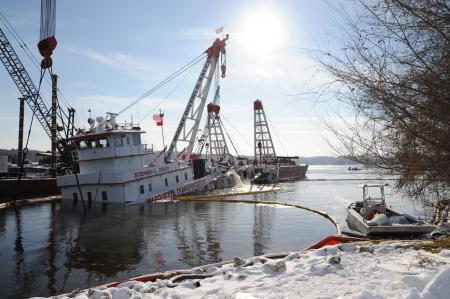
| Jan. 2014 | |||||||||||
| Top stories | |||||||||||
| In the news | |||||||||||
| Photos | |||||||||||
| Contact us | |||||||||||
| Archive | |||||||||||
|
Lab aids investigation of sunken towboat |
By Cindy Hadish
Laboratory staff helped determine the course of action after an unusual accident on the Mississippi River.
A 154-foot towboat carrying about 100,000 gallons of diesel fuel sank Nov. 25, after striking a submerged object in the river near LeClaire.
 Salvage and response crews
for the Stephen L Colby cleanup petroleum products on Dec. 3 that leaked into Mississippi
River new LeClaire after the towboat hit a large rock in the river channel on Nov. 25. (U.S.
Coast Guard photo by Petty Officer 3rd Class Jonathan Lally)
Salvage and response crews
for the Stephen L Colby cleanup petroleum products on Dec. 3 that leaked into Mississippi
River new LeClaire after the towboat hit a large rock in the river channel on Nov. 25. (U.S.
Coast Guard photo by Petty Officer 3rd Class Jonathan Lally) Environmental lab supervisor Terry Cain said staff conducted tests on water samples collected after the accident, at the request of the Iowa Department of Natural Resources.
"We do a lot of water testing of various kinds, including for different kinds of spills," said Cain, adding that the towboat sinking was likely a first.
Cain noted that the lab often assists state and local agencies as part of the State Hygienic Laboratory's mission to protect Iowa's environmental quality and public health.
In fiscal 2013, for example, the Environmental Health Division performed more than 150,000 tests on more than 64,000 samples submitted.
While some tests are routine, the towboat accident required a rapid turn-around, Cain said, as investigators tried to determine how much fuel leaked into the river and how far it spread.
"The main concern was the diesel fuel because there was so much of it on the tugboat," he said, citing the potential hazard to drinking water and from exposure, as well as risks to aquatic life.
Jeff Thomann, an environmental specialist for the DNR, said the tests performed by the lab during three time periods helped agencies working on the investigation - including the U.S. Fish & Wildlife Service and U.S. Coast Guard - to determine the contaminants involved and the extent of the fuel's spread.
Thomann agreed that the accident was out of the ordinary; his supervisor, who had been with the DNR for more than 30 years, said it was the first time a large towboat sank in his career, posing potentially widespread environmental and safety risks.
"Something of this magnitude is unusual," he said, noting that the lab tests, fortunately, showed nothing that raised alarms.
All nine crew members safely escaped the towboat, which sank within 12 minutes of striking the object, Thomann said. A final report has not been released as of Jan. 10, but Lt. Kody Stitz of the Coast Guard said the investigation showed that the towboat struck a rock.
The vessel was pushed toward shore and absorbent booms were placed in the water after the accident to contain oil and diesel fuel.
Thomann said the lab tested samples of river water for the presence of diesel fuel, motor oil, ethylene glycol - a component found in antifreeze - and other contaminants.
 Staff from the Hygienic
Laboratory’s Environmental Health Division who tested for petroleum products in water from
the Mississippi River are (from left, front row) Marie Assem, analytical chemist, and
laboratory technicians Peter Ma and Rick Derrig. Pictured in the back row are Terry Cain,
environmental lab supervisor; Karla Benninghoven, laboratory technician; and Sarah May,
environmental lab supervisor.
Staff from the Hygienic
Laboratory’s Environmental Health Division who tested for petroleum products in water from
the Mississippi River are (from left, front row) Marie Assem, analytical chemist, and
laboratory technicians Peter Ma and Rick Derrig. Pictured in the back row are Terry Cain,
environmental lab supervisor; Karla Benninghoven, laboratory technician; and Sarah May,
environmental lab supervisor. "We wanted to see if any contamination reached beyond the booms downriver," he said. "We determined that very little was getting through the booms."
Mike Coffey, pollution biologist with U.S. Fish and Wildlife Service, said there were no fish kills, but one mallard that was found alive and later died and a dead Canada goose were both coated by oil. Coffey said both seemed to have had pre-existing injuries.
According to the Coast Guard, about 38,900 gallons of oily-water mixture were recovered from the Mississippi, 89,000 gallons of oily-water mixture were recovered from the towboat and 6,900 cubic feet of oily waste came from the booms.
Three holes on the towboat’s hull were patched and decontamination was performed before the towboat, the Stephen L. Colby, owned by Paducah, Ky.-based Marquette Transportation Co., was sent on to St. Louis.
Thomann said the DNR will return to the area in the spring to see if any oily residue or sheens remain.